Landscape Gardening in Barbican
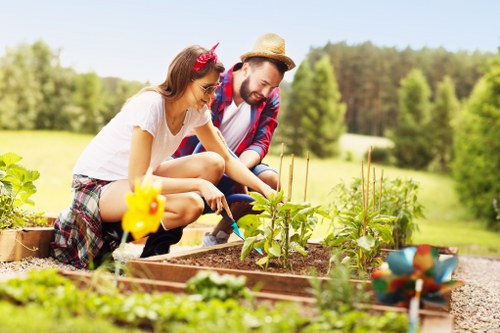
Welcome to the vibrant world of landscape gardening in Barbican, where green spaces meet urban sophistication. Whether you're a seasoned gardener or a novice looking to transform your outdoor area, Barbican offers a unique blend of opportunities to create stunning landscapes that enhance both aesthetics and functionality.
Barbican, known for its modern architecture and bustling city life, provides a distinct backdrop for landscape gardening. The challenge lies in harmonizing natural elements with the urban environment, ensuring that each garden not only thrives but also complements the surrounding infrastructure.
In this article, we will explore the various aspects of landscape gardening in Barbican, including design principles, plant selection, sustainable practices, and maintenance tips. By the end, you'll be equipped with the knowledge to create a breathtaking garden that stands out in the heart of the city.
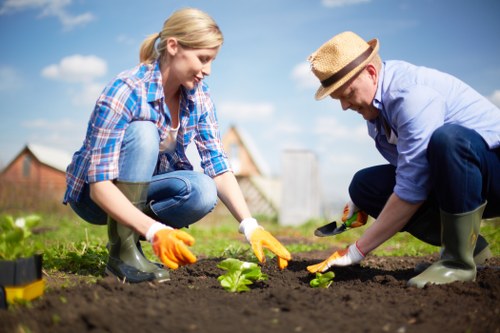
Understanding the Barbican Environment
Before diving into the design process, it's essential to understand the specific environmental conditions of Barbican. The area's climate, soil type, and available space all play crucial roles in determining the success of your garden.
Climate: Barbican experiences a temperate climate with moderate rainfall throughout the year. Winters can be cold, while summers are generally warm, making it conducive to a wide variety of plants.
Soil Quality: The soil in Barbican is predominantly urban, often compacted and lacking in organic matter. Incorporating compost and other soil amendments can significantly improve soil health, promoting robust plant growth.
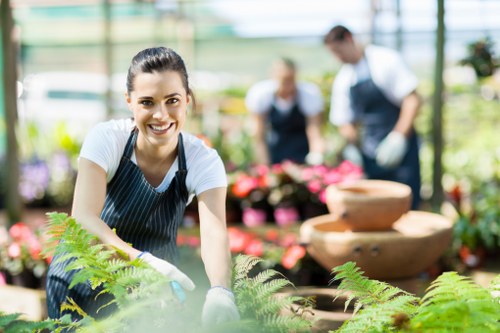
Design Principles for Urban Gardens
Effective landscape gardening in an urban setting like Barbican requires thoughtful design that maximizes limited space while creating a serene oasis. Here are key principles to consider:
- Space Optimization: Utilize vertical gardening techniques, such as trellises and hanging planters, to make the most of limited ground space.
- Balance and Harmony: Ensure a balanced composition by mixing different plant heights, textures, and colors.
- Functionality: Design spaces that serve multiple purposes, such as seating areas, pathways, and recreational zones.
- Sustainability: Incorporate sustainable practices like rainwater harvesting and native plant selection to promote environmental stewardship.
By adhering to these principles, you can create a landscape that is both beautiful and practical, enhancing your living space while contributing to the overall greenery of Barbican.
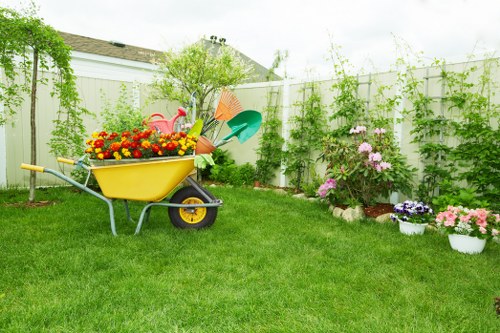
Choosing the Right Plants
Plant selection is a cornerstone of successful landscape gardening. In Barbican, it's important to choose plants that can thrive in an urban environment and complement the local climate.
Native Plants
Opting for native species is a sustainable choice that supports local biodiversity. Native plants are well-adapted to the climate, requiring less maintenance and water.
Popular Native Plants in Barbican
- Hydrangeas: Known for their vibrant blooms and adaptability.
- Lavender: Offers fragrant flowers and attracts pollinators.
- Boxwood: Ideal for creating structured hedges and borders.
- Ornamental Grasses: Add texture and movement to the landscape.
Incorporating these plants can lead to a resilient and aesthetically pleasing garden that thrives with minimal intervention.
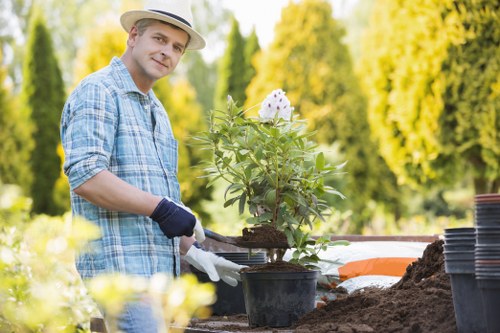
Sustainable Gardening Practices
Incorporating sustainable practices into your landscape garden not only benefits the environment but also ensures long-term garden health.
Water Conservation
Implementing water-efficient techniques is essential, especially in urban areas where water resources can be limited. Consider the following methods:
- Rainwater Harvesting: Collecting and storing rainwater for irrigation needs.
- Drip Irrigation: Delivers water directly to plant roots, minimizing waste.
- Mulching: Retains soil moisture and reduces the need for frequent watering.
These strategies help maintain a healthy garden while reducing water consumption.

Incorporating Hardscapes
Hardscapes play a pivotal role in landscape gardening, providing structure and functionality to outdoor spaces.
Pathways and Patios
Creating clear pathways and inviting patios enhances the usability of your garden. Materials such as stone, gravel, and pavers are popular choices that offer durability and aesthetic appeal.
Choosing the Right Materials
Select materials that complement the overall design theme of your garden. For example, natural stone can add a rustic charm, while sleek concrete offers a modern look.
- Stone: Durable and timeless, ideal for walkways and patios.
- Gravel: Cost-effective and easy to install, suitable for informal paths.
- Pavers: Versatile and available in various patterns, perfect for creative designs.
Integrating hardscapes thoughtfully can significantly enhance the visual appeal and functionality of your landscape.

Lighting and Ambiance
Proper lighting can transform your garden, extending its usability into the evening hours and highlighting key features.
Types of Garden Lighting
There are several lighting options to consider:
- Path Lights: Illuminate walkways, ensuring safety and adding sparkle.
- Spotlights: Highlight specific plants or architectural elements.
- String Lights: Create a cozy and inviting atmosphere in seating areas.
Choosing the right lighting not only enhances beauty but also provides practicality, making your garden a welcoming space day and night.

Seasonal Considerations
Designing a garden that offers year-round interest requires careful planning and plant selection.
Spring
Spring is a time of renewal, perfect for planting perennials and flowering bulbs. Vibrant colors from tulips and daffodils can kickstart your garden's seasonal display.
Summer
The warmth of summer calls for drought-tolerant plants and ample shade. Incorporate herbs and vegetables for a productive landscape.
Autumn
Autumn brings rich hues and falling leaves. Consider integrating foliage plants like chrysanthemums and ornamental trees that showcase stunning leaf colors.
Winter
Winter gardens can be just as captivating with evergreens and ornamental branches. Adding structure through hardscapes ensures your garden remains visually appealing even in the colder months.

Maintenance Tips
Maintaining a landscape garden in Barbican requires consistent care to ensure its longevity and beauty.
Regular Pruning
Pruning helps shape plants, removes dead or diseased branches, and promotes healthy growth. It's essential to prune at the right time of year for each plant type.
Weeding and Mulching
Keeping your garden free from weeds reduces competition for nutrients. Applying mulch not only suppresses weed growth but also retains soil moisture and regulates temperature.
Fertilization
Feeding your plants with appropriate fertilizers supports their growth and vitality. Organic fertilizers are a sustainable choice that enrich the soil naturally.
- Compost: A rich source of nutrients, ideal for all plant types.
- Bone Meal: High in phosphorus, perfect for root development.
- Fish Emulsion: A fast-acting fertilizer that promotes lush foliage.
Regular maintenance ensures that your landscape garden remains a thriving and attractive feature of your Barbican home.

Professional vs. DIY Landscaping
Deciding between hiring professionals or undertaking a DIY approach depends on your budget, time, and expertise.
Advantages of Professional Landscaping
Professionals bring expertise, creative design ideas, and efficient execution. They can navigate challenges specific to urban gardening, ensuring a polished and functional result.
- Expert Advice: Guidance on plant selection, design principles, and maintenance.
- Time Efficiency: Professionals can complete projects faster due to their experience and resources.
- Quality Assurance: Ensures that the final outcome meets high standards of aesthetics and functionality.
Benefits of DIY Landscaping
Undertaking landscaping yourself can be cost-effective and personally rewarding. It allows for complete creative control and can be tailored to your specific preferences.
- Cost Savings: Save on labor costs by handling tasks independently.
- Personal Satisfaction: Enjoy the process of creating and nurturing your garden.
- Flexibility: Make changes and adjustments at your own pace.
Ultimately, the choice depends on your individual circumstances and goals for your landscape garden in Barbican.

Integrating Technology in Landscape Gardening
Modern technology offers innovative solutions to enhance your landscape gardening experience. From smart irrigation systems to garden design software, technology can make maintaining your garden more efficient and enjoyable.
Smart Irrigation Systems
These systems use sensors and automated controls to optimize water usage, ensuring that your plants receive the right amount of moisture without waste.
Garden Design Software
Design software allows you to visualize your garden layout, experiment with plant arrangements, and plan hardscape elements before implementation.
Examples of Useful Technologies
- Weather Stations: Monitor local weather conditions to adjust gardening practices accordingly.
- LED Grow Lights: Enhance plant growth during low-light conditions in urban settings.
- Automated Fertilizers: Ensure consistent nutrient delivery to your plants.
By embracing technology, you can create a more responsive and thriving landscape garden in Barbican.

Community Gardening in Barbican
Community gardens foster a sense of belonging and provide shared green spaces in urban areas. Engaging in community gardening in Barbican offers numerous benefits.
Social Interaction
Participating in a community garden allows you to connect with fellow residents, share gardening tips, and collaborate on projects, enhancing the social fabric of the neighborhood.
Environmental Impact
Community gardens contribute to urban biodiversity, improve air quality, and create habitats for pollinators and other beneficial wildlife.
How to Get Involved
- Join Local Groups: Connect with local gardening clubs or community organizations.
- Volunteer: Offer your time and skills to maintain and develop communal green spaces.
- Attend Workshops: Participate in educational sessions to enhance your gardening knowledge.
Engaging in community gardening not only enriches your personal gardening experience but also enhances the overall quality of life in Barbican.

Conclusion
Landscape gardening in Barbican is an enriching endeavor that blends the beauty of nature with the dynamism of urban life. By understanding the local environment, adhering to design principles, selecting appropriate plants, and maintaining sustainable practices, you can create a garden that not only thrives but also enhances your living space.
Whether you choose to embark on this journey alone or enlist the help of professionals, the rewards of a well-crafted landscape garden are immense. Embrace the opportunities that Barbican offers and transform your outdoor space into a stunning sanctuary.
Ready to transform your garden? Contact us today to explore personalized landscape gardening services tailored to your needs.